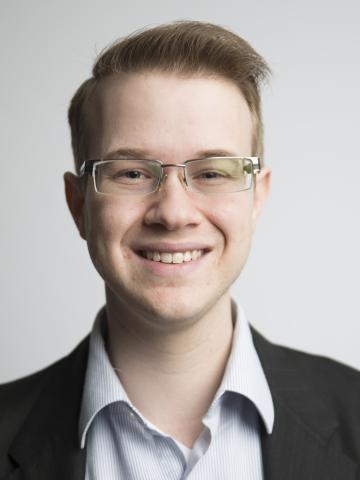Member for
3 years 10 monthsMedical Device Innovation / Clinically Translational Technology
EDUCATION 08/2014 – Present: Doctor of Philosophy in Bioengineering, Dept. Electrical Engineering Georgia Institute of Technology, Atlanta, GA - 3.76 Focus: Clinically Translatable Research / Medical Device Innovation Dr. Todd Sulchek – BioMEMS NIH T32 Cell and Tissue Training Grant, Technological Innovation Generating Economic Results 08/2017 – Present: Masters of Business Administration, Managing Innovation & Technology Georgia Institute of Technology, Atlanta, GA - 3.67 05/2013 – 05/2014 Masters of Science in Engineering in Bioengineering Innovation and Design Johns Hopkins University, Baltimore, MD - 3.82 08/2009 – 12/2012 Bachelors of Science in Biomedical Engineering Specialization: Medical Robotics and Devices Bachelors of Science in Applied Mathematics and Statistics Johns Hopkins University, Baltimore, MD - 3.19 EXPERIENCE 09/2014 - Present Cofounder / CEO Insight Optics, Inc. Atlanta, GA Product and marketing strategy development, implementation, and testing Responsible for hiring, staff management, networking, and sales (5-15 colleagues) Raised over $400,000 from private equity, grants, accelerators, and pitch competitions Product and marketing strategy development, implementation, and testing Responsible for hiring, staff management, networking, and sales (5-15 colleagues) Raised over $400,000 from private equity, grants, and pitch competitions Pilot Study Coordinator, Beta testing, and Quality Systems Coordinator Graduate Research Associate Protocol development and data analysis for particle isolation via dead-end filtration Rapid prototyping of laboratory equipment for experimentation and lab automation Responsible for training new users on laboratory equipment including laser systems Paper, Patent, and Grant submission surrounding novel techniques developed in lab Oral and/or poster presentation preparation and delivery monthly Management of multiple international research teams up to 15 students at a time 05/2013 – 05/2014 Medical Device Designer Center for Bioengineering Innovation and Design, JHU Baltimore, MD Surgical shadowing leading to insight translation, ideation, clustering and prioritization, technology scouting, and concept synthesis In-field, overseas device feasibility testing and functionality analysis PCB design, rapid prototyping, testing, and manufacturing for noninvasive hemoglobinometery and noninvasive intracranial pressure monitors 06/2012 – 05/2013 Course Developer and Lab Manager Department of Mechanical Engineering, Johns Hopkins University Baltimore, MD Redesign and construction of the Hopkins Haptic Paddle Designed, machined, and constructed Vibration and Torsion Lab Matlab, LabView, Wiring, and C++ coding for device communication 10/2010 – 05/2013 Product Manager Neuroengineering and Biomedical Instrumentation Lab, Johns Hopkins U Baltimore, MD Infinite Biomedical Technologies Baltimore, MD WISP RFID programming and integration into myoelectric prosthetics Myoelectric Prosthetic device development, programming, and testing Microchip programming, soldering, board design, and system integration Pattern recognition software and hardware development and integration 05/2011 – 08/2011 06/2010 – 08/2010 Research Associate Ophthalmic Biophysics Center, Bascom Palmer Eye Institute Miami, FL Data analysis for research in human and primate crystalline lens visual optics and accommodation restoration (statistical analysis of image and load data) Participate in lab work related to the optic-mechanical properties of the eye Independent projects assessing the accuracy of the EVASII measurement system and proving intralenticular pressure through empty bag experimentation MATLAB image and data processing programming PUBLICATIONS 1. Enten A, Yang Y, Ye Z, Chu R, Van T, Rothschild B, Gonzalez F, Sulchek T. A Liquid-Handling Robot for Automated Attachment of Biomolecules to Microbeads. J Lab Autom [Internet]. 2015 Aug 26 [cited 2016 May 16]; Available from: http://www.ncbi.nlm.nih.gov/pubmed/26311061 PMID: 26311061 2. Enten AC, Nankivil D, Maceo B, Arrieta E, Manns F, Parel J-M. Optomechanical Response of Primate Lenses: Effects of Decentration. Invest Ophthalmol Vis Sci [Internet]. The Association for Research in Vision and Ophthalmology; 2011 Apr 22 [cited 2016 Apr 12];52(14):816. Available from: http://iovs.arvojournals.org/article.aspx?articleid=2351378&resultClick=1
Dead-end filtration using patterned microsieves, fiber meshwork, and membranes of various materials is a standard technique to isolate desired particles of various sizes and is used in clinical and laboratory settings for both therapeutic and diagnostic applications. Both biological and physical suspensions can be filtered to yield high purity and enrichment at a high throughput. Unfortunately, dead-end filters are especially susceptible to fouling, which leads to lower recovery percentage and yield as a direct result. High recovery percentages, enrichment, and throughput determine the success of sorting technologies. A process which could stop fouling, reintegrate the fouling material into the bulk flow, and allow for further processing could be used to improve the recovery percentage of dead-end systems increasing their success and use. The purpose of this research is to determine if novel flow profiles with variable duty cycles can reduce fouling and improve permeate flux without substantial tradeoffs to processing time by controlling forward volume flow rate, reverse volume flow rate, and the time spent in each phase. This objective was accomplished through 1) the development of pulse modulated (PM) periodic backflush using a square wave duty cycle fluid flow control systems to interrupt membrane fouling, 2) the development of a model to better understand how experimental results compare to what might be achievable, 3) the optimization of amplitude and frequency to reduce and minimize costs to throughput by increasing yield, and 4) demonstration that the control algorithms can be applied to important applications of particle purification, cell enrichment, and scaffold seeding. These practical tests also help to define the conditions upon which the developed methods optimally apply. Ultimately, this thesis work established that pulse modulation is an effective technique to interrupt fouling and reintegrate the cake into the bulk flow to improve the recovery percentage of both microparticle and cellular products while minimizing the anticipated costs to throughput.

